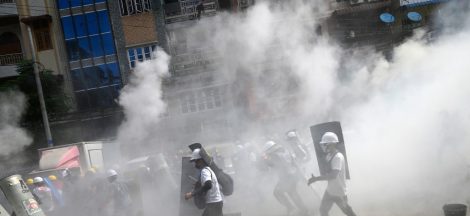Industry 4.0 vs creative sector: Disruptive or constructive? The term “4.0” has become widely used in the past few years. From government 4.0 to tourism 4.0, this suffix seems to be something that must be attached to every concept and movement to welcome the era of Industry 4.0. But is it used appropriately, or is it actually keeping Indonesia from benefiting even further from unexplored economic potential?

Generally, technology or industry aims to increase productivity and reduce the use of human resources, disrupting previous technology providing business opportunities. Through this process start-ups evolve and create solutions to tackle inefficient business problems.
The creative economy is a reaction to the increasing demands for lifestyle and entertainment products. This demands leads to further demand for content, which in their creation and production are deeply related to creative industry. However, traditional creative industry alone is not enough to face the challenge, one also has to understand how the expertise of the business and the business model can be implemented to create a more valuable and creative product.
In countries such as Japan, Korea and China, the creative economy is the spearhead of their economic growth. The governments have encouraged many strategies and policies to keep their creative industries developed as soft power or cultural diplomacy, and as the creation of new economic power chains.
In 1974 there occurred an event in Indonesia known as Malapetaka Limabelas Januari (January 15 Havoc) or Malari. At the time, then president Soeharto and several ministers were welcoming Japan’s then prime minister Tanaka Kakuei. Students held large-scale demonstrations against foreign capital, especially Japanese, and burned Japanese manufactured goods at several points in the capital. They insisted that they did not want Indonesia to be economically colonized again. In an article written by Husain Abdulsalam entitled “Malari 1974: Protes Mahasiswa yang Ditunggangi Para Jenderal” (Malari 1974: Student Protests Ridden by Generals, 2018), the incident is considered to be “the first major protest after the New Order came to power”.
Twenty-four years later, Indonesia’s youth gathered at Jakarta’s Blok M Square to celebrate Japanese cultural day echinnisai and many even wore traditional Japanese clothing. Japanese cuisine is now also commonplace in the capital, from the very affordable that can be found in roadside stalls to that sold in upmarket shopping malls. Entertainment content originating from Japan, such as Tamagochi, Pokemon, Doraemon and Sailormoon have their own place in the hearts of the Indonesian public. The boost has occurred not only with culture-based products, but other Japanese mass-produced products. According to data from the Association of Indonesian Automotive Industries (Gaikindo), Japanese cars overwhelmingly dominated the car sales market in Indonesia in 2017.
Japan started and began to intensify its cultural diplomacy strategy after its defeat in the Second World War. The country was aware that it was important to change its image and improve the nation’s branding in more subtle ways. This creative economic strategy introduced Japanese creative products in Indonesia in the early 80s, namely games (Nintendo) and television shows (Oshin). The national strategy called Cool Japan was designed to increase exports of intellectual property (IP) or cultural content based on manga (pictorial stories or comics), anime (animation), drama, movies, novels, games and toys.
The creative economy involves creative processes and creative products that are loaded with cultural values and using them to influence others. The creative economy now involves political and economic values. At this stage, the creative economy focuses on two main things: the creation of soft power, or what is commonly called the power of cultural diplomacy, and the export of creative content or the export of cultural content.
Korea also has its own cultural strategy. In 1994 then president Young-sam Kim gave support and subsidies for local content production. At the time, Hollywood dominated 80 percent of the Korean market, while the local film industry market share dropped to 15.9 percent. Moreover, Kim was also forced to review the total revenue of Hollywood’s film Jurassic Park, which exceeded the revenue of Hyundai automobiles at more than US$1.5 billion. The Korean Ministry of Culture then initiated a cultural industry bureau to manage the cultural sector, which also led and encouraged investors to extend into film and other media.
In the following years, the Korean creative sector showed significant progress. In 1996, Korean mythology-based game Nexus was launched and in 1998 it reached the beta phase in the US. In 1999, Korea’s first big-budget film, Shiri, earned $11 million in revenue and surpassed Hollywood’s Titanic. In the same year, Korean boy band H.O.T. became the first group to perform abroad in a sold-out concert held in Beijing. This is how the Koreans implemented their cultural strategy, which is also known as Hallyu or the Korean wave.
In the case of Indonesia’s Industry 4.0, the use of start-ups and creative economy terminology are commonly misused interchangeably, whereas the two have very distinct natures in terms of basic concepts, business model and even purpose.
Industry 4.0, which is reflected in start-ups, intends to solve a problem by creating the solution. The most common questions that start-ups try to answer are what is a problem that it can solve and what kind of solution can a start-up provide? However, the solution offered usually disrupts an inefficient business process and this changes the way businessmen do their business.
Within the creative economy, when an IP creator wants to produce a comic, film, piece of music or game, he or she will not encounter such questions, as the main drive for the industry is not production efficiency but the quality of the content. However, the actual challenge that the creative sector must face is everything related to the balance of trade: how much the creative sector’s exports are worth compared with their imports.
In Indonesia, spinning tops are handmade crafts. They are regarded as traditional toys, selling for no more than Rp 20,000 (less than US$1.50). However, by empowering its creative industry, Japan succeeded in creating comics, animation and toys revolving around spinning tops, so much that they are worth a thousand times more than traditional Indonesian tops.
In 2013, Pokémon’s IP collected revenue from Japan fashion and merchandise of more than $890 million. This IP alone produced more than US$21 billion, making the IP the highest-grossing media franchise. The creative sector’s role in the national economy is considered highly important, since the economic value chain formed by the industry will disrupt but enhance other sectors of the creative economy. This is the power of the creative economy, every sector is able to support and empower each other.
Unfortunately, in Indonesia the ambiguity between Industry 4.0 and the creative economy means the latter is seen and viewed in the same context as Industry 4.0, both by the public and even policymakers. This weakens the creative economy even further and puts it at a disadvantage. Whereas, if we look to other countries as Japan, Korea and China, where they treat their creative sectors with the right understanding and mindset, Indonesia may, too, be able to make the creative economy a featured national program, creating new economic power that can be beneficial for Indonesia. Industry 4.0 vs creative sector: Disruptive or constructive? (dev//wng, *Ninoi Kiling, The Jakarta Post) *Ninoi Kiling, the writer is a game designer in a local game developer located in Jakarta.






 Govt to Establish National Action Plan on Business and Human Rights
Govt to Establish National Action Plan on Business and Human Rights 